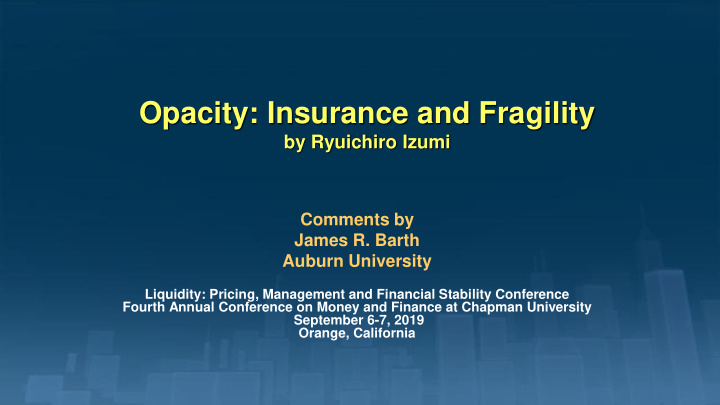



Opacity: Insurance and Fragility by Ryuichiro Izumi Comments by James R. Barth Auburn University Liquidity: Pricing, Management and Financial Stability Conference Fourth Annual Conference on Money and Finance at Chapman University September 6-7, 2019 Orange, California
Purpose and Findings ⚫ Develop a theoretical model to examine ⚫ the effects of banks’ holding opaque, complex assets and ⚫ whether regulators should require bank assets to be more transparent. ⚫ It is found that ⚫ the opacity of a bank’s assets is a way of providing insurance to the bank’s depositors, ⚫ but excessive opacity increases the susceptibility to runs, ⚫ so that the regulators could improve welfare by restricting opacity, such as by a restriction on asset types or structures in which banks can invest.
Comments ⚫ Clearly, the paper addresses important and timely issues. ⚫ There are, not surprisingly, some comments and questions I have as a discussant of the paper. ⚫ The approach to my assignment essentially follows the dictum of Lord Kelvin: If you can not measure it, you can not improve it. ⚫ I therefore focus on the possible implications of the model for empirical work that would help determine the best approach to promoting a well-functioning banking system.
Questions ⚫ The study focuses on banks’ holding opaque, complex assets. What about complex organizational structures, such as bank holding companies with different types of subsidiaries located in different geographic areas? ⚫ Does it matter whether depositors have access to federal deposit insurance or not? This is an important feature of the banking system today. ⚫ Could capital requirements be introduced into the model that are tied to the risk-weighting of opaque, complex assets, and thereby be an appropriate policy intervention?
Questions ⚫ Could fraud, which was a factor in the most recent financial crisis, be easily introduced into the model? ⚫ It is assumed that depositors are risk-averse, while investors are risk-neutral. Is it easy to modify the model so that investors can also be risk-averse and have an objective function rather than simply purchasing assets in whatever quantity depositors desire? ⚫ A key assumption is that the assets will be traded at a discounted pooling price. Can this assumption be relaxed?
Questions ⚫ Is it reasonable to assume a bank chooses a level of opacity to maximize the expected utility of depositors? ⚫ Does the model imply anything about a bank maximizing expected profits? ⚫ Is it reasonable to study an environment of symmetric information? Other studies cited assume that a regulator and/or bank have more information about banks’ assets than depositors.
Questions ⚫ What does it mean to say that “…the paper studies an environment with limited commitment and, hence, partial runs possibly occur”? ⚫ Opacity is measured by the time length to reveal the realization of asset returns in period 1, and the time is measured by the number of withdrawals. Is regulation that limits opacity to improve welfare designed to limit the number of withdrawals? If so, how is a restriction on asset types or structures in which banks can invest consistent with limiting the number of withdrawals?
Thank You!
Recommend
More recommend